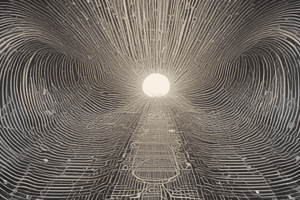Podcast
Questions and Answers
What was a significant reason for the decline of vibration therapy in the early 20th century?
What was a significant reason for the decline of vibration therapy in the early 20th century?
- Lack of research funding
- The invention of new medical technologies
- Negative perceptions of its effectiveness
- World War I and WWII (correct)
Which country prominently adopted vibration therapy for athletic recovery in the 1970s?
Which country prominently adopted vibration therapy for athletic recovery in the 1970s?
- Germany
- Russia (correct)
- Italy
- United States
What important discovery was made by Vladimir Nazarov and his colleague Spivak regarding vibration therapy?
What important discovery was made by Vladimir Nazarov and his colleague Spivak regarding vibration therapy?
- It has no measurable effects on muscle performance
- It is only beneficial for older adults
- It reduces fat more effectively than exercise
- It can increase muscle capacity and stimulate bone regeneration (correct)
Why was vibration therapy utilized for Russian cosmonauts?
Why was vibration therapy utilized for Russian cosmonauts?
What did Carmelo Bosco contribute to the field of vibration therapy?
What did Carmelo Bosco contribute to the field of vibration therapy?
What is the origin of the word 'vibration'?
What is the origin of the word 'vibration'?
Which type of vibration exposure primarily affects workers that use power tools?
Which type of vibration exposure primarily affects workers that use power tools?
What is a potential therapeutic effect of slow frequency vibrations?
What is a potential therapeutic effect of slow frequency vibrations?
Which of the following inventions was created by Jonas Gustav Zander?
Which of the following inventions was created by Jonas Gustav Zander?
What health issue can prolonged whole-body vibration exposure potentially cause?
What health issue can prolonged whole-body vibration exposure potentially cause?
In which century was the 'tremorsoir' developed, an early vibrating device for health benefits?
In which century was the 'tremorsoir' developed, an early vibrating device for health benefits?
Which frequency of vibrations is associated with the use of handheld devices for therapy?
Which frequency of vibrations is associated with the use of handheld devices for therapy?
What role did Jean Martin Charcot play in the history of vibration therapy?
What role did Jean Martin Charcot play in the history of vibration therapy?
Flashcards
Vibration Therapy
Vibration Therapy
The use of vibrations to improve physical health and performance.
Why was vibration therapy sidelined?
Why was vibration therapy sidelined?
Vibration therapy was largely ignored during World War I and World War II.
How did vibration therapy regain interest?
How did vibration therapy regain interest?
Increased research in health during the 1960s led to a revival of interest in the benefits of vibration.
What did Russians discover about vibration therapy?
What did Russians discover about vibration therapy?
Signup and view all the flashcards
When was the first whole-body vibration machine made?
When was the first whole-body vibration machine made?
Signup and view all the flashcards
Vibration
Vibration
Signup and view all the flashcards
Occupational Vibration Exposure
Occupational Vibration Exposure
Signup and view all the flashcards
Therapeutic Vibration
Therapeutic Vibration
Signup and view all the flashcards
Low Frequency Vibration
Low Frequency Vibration
Signup and view all the flashcards
Middle Frequency Vibration
Middle Frequency Vibration
Signup and view all the flashcards
High Frequency Vibration
High Frequency Vibration
Signup and view all the flashcards
Whole Body Vibration Platforms
Whole Body Vibration Platforms
Signup and view all the flashcards
History of Therapeutic Vibration
History of Therapeutic Vibration
Signup and view all the flashcards
Study Notes
Introduction to Vibration
- Vibration is a mechanical phenomenon involving oscillations around an equilibrium point, repeatedly moving back and forth.
- The term "vibration" derives from the Latin "vibratio," meaning "shaking" or "brandishing."
- Oscillations can be periodic (like a pendulum) or random (like a tire on gravel).
Occupational Vibration Exposure
- Prolonged vibration exposure can be harmful to workers.
- Hand/arm vibration from power tools can negatively impact blood flow and sensation in the fingers.
- Whole-body vibration from machinery and vehicles can cause circulatory, bowel, respiratory, muscular, and back issues.
- Machine-produced vibrations typically fall between 2 and 3 Hertz, lower than exercise-based whole-body vibration.
Therapeutic Vibration
- Vibration, in controlled doses, can offer therapeutic benefits.
- Slow-frequency vibrations (e.g., rocking, horseback riding, washing machines) reduce muscle tone.
- Mid-frequency vibrations (e.g., massage techniques, percussion tools) stimulate the nervous system, loosen muscles, and aid in clearing lung secretions.
- High-frequency vibrations (e.g., handheld devices) stimulate areas of low muscle tone and promote muscle contraction.
- Whole-body vibration platforms enhance muscle strength, bone density, circulation, and balance.
History of Therapeutic Vibration
- Ancient Greek warriors used vibrating wooden or bow-like tools to drain pus and aid wound healing.
- Horseback or donkey riding was believed to facilitate recovery.
- Ancient texts suggest health benefits from carriage rides with uneven wheels.
- A 16th-century Japanese document noted vibration's potential health advantages.
- The 18th century saw the "tremorsoir," a spring-loaded chair, created for the frail.
- The 19th century saw vibration use in reducing illness, supporting cardiovascular health, and addressing digestive issues.
- French neurologist Jean Martin Charcot developed a vibrating chair for Parkinson's treatment, based on observations from train travel and carriages.
Evolution of Vibration Therapy
- Jonas Gustav Zander, known as the "father of modern exercise," developed the Zander Wrapper, a vibrating device mimicking horseback riding.
- John Henry Kellogg improved upon Zander's design, creating the first steam-powered whole-body vibration machine.
- Vibration therapy experienced a decline in use due to World War I and II.
- Renewed health research in the 1960s resumed studies on vibration's impact.
- Russia employed vibration therapy in the 1970s to aid athletes' recovery.
- Vladimir Nazarov and colleague Spivak discovered vibration's potential to boost muscle strength and stimulate bone regeneration.
- Vibration therapy supported Russian cosmonauts experiencing bone loss in space.
- Carmelo Bosco, an Italian physiologist, created the first readily available whole-body vibration machine for gyms and homes.
- Modern vibration devices provide high-frequency vibrations for warm-ups, cool-downs, pain reduction, flexibility training, bone density improvement, muscle strengthening, flexibility enhancement, proprioception, and motor control.
Studying That Suits You
Use AI to generate personalized quizzes and flashcards to suit your learning preferences.




